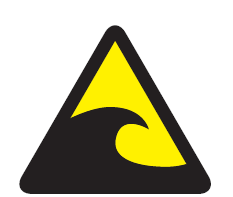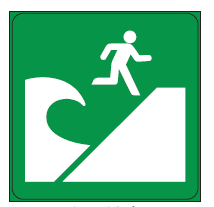Tsunami
Tsunami are a tragic reality of living on the coast of Iwate. In the past one hundred years, three large tsunami have devastated the coastal communities of Sanriku. The 1933 Showa Sanriku tsunami, the 1960 earthquake in Chile which caused a tsunami to cross the Pacific to hit Sanriku again, and then the 2011 earthquake and tsunami. An earthquake and tsunami on that scale are something that are said to only happen once a millennia (the last one of such size struck in the year 869), but smaller tsunami do happen once every couple of decades and cause massive damage as well.
The only thing you can do to save yourself from a tsunami is to get to higher ground. This should be your number one priority after feeling an earthquake on the coast. Don’t wait for an order to evacuate – move immediately for higher ground. Always evacuate by foot. Go as far and as high as you can because every little bit helps. If you don’t think you’ll make it to higher ground, try to get to the top of a building.
On this page
- Characteristics of tsunami
- Prepare in advance
- Tsunami warnings and advisories in Japanese
Characteristics of Tsunami
Tsunami are sometimes called tidal waves, but they are not really like a wave. During a tsunami, the tide of the ocean rises and rises until it starts to encroach on land, sometimes with terrifying speed. The tsunami can come in once and completely recede, or it can undulate back and forth. Do not go back to the area until you receive official word that it is safe.
Prepare in advance
- If you live in a coastal area, know the places you would evacuate to in case of a tsunami. Practice getting there and participate in evacuation drills held in the area.
- Decide a place to meet with your family if you have to evacuate
- If you are visiting a coastal area, keep on the lookout for tsunami evacuation signs and what not that would direct you to higher ground in case of a tsunami.
- Participate in disaster drills (防災訓練, bousai kunren) or evacuation drills (避難訓練, hinan kunren). Your local neighborhood association may hold such drills, or you can inquire at your local municipal hall.

This sign is seen often on the coast; it means this is a zone where tsunami can reach. You’ll also see signs in English called “Tsunami Inundation Zones,” which means you are in an area vulnerable to waves.

This sign is to signal tsunami evacuation points. Look for these signs after an earthquake to find out where to go to get to higher ground.
Information after a tsunami
Rumors can circulate quickly when accurate information is hard to get. It’s best to get your information from an official source like the TV or radio, or official websites like the Japan Meteorological Agency or prefectural website.
Tsunami Warnings and Advisories
|
Japanese |
English |
|---|---|
|
津波注意報 (20cm - 1m) |
Tsunami Advisory - Tsunami waves reaching up to 1 m may be anticipated. |
|
津波警報 (1m - 3 m) |
Tsunami Warning - Tsunami waves reaching up to 1-3 m may be anticipated. Please exercise extreme caution |
|
大津波警報(特別警報) (3m and over) |
Major Tsunami Warning - Tsunami peaks over 3m are anticipated. Please exercise extreme caution. |
このページに関するお問い合わせ
Office of International Affairs, Department of Homeland Promotion
(020-8570) 10-1 Uchimaru, Morioka City, Iwate Prefecture, JAPAN
Phone number:019-629-5765 Facsimile:019-629-5254
You can access our question form here.

